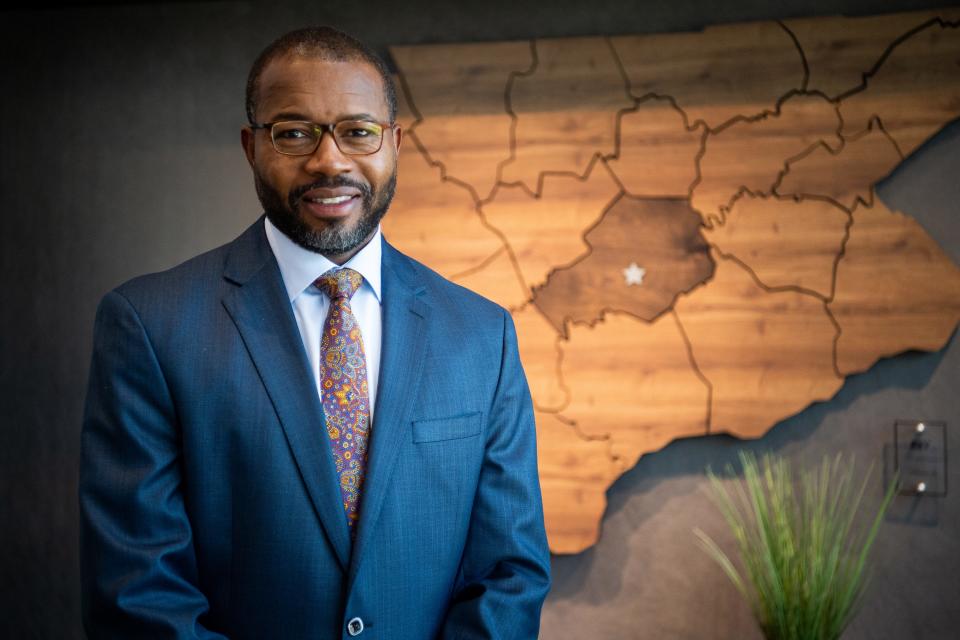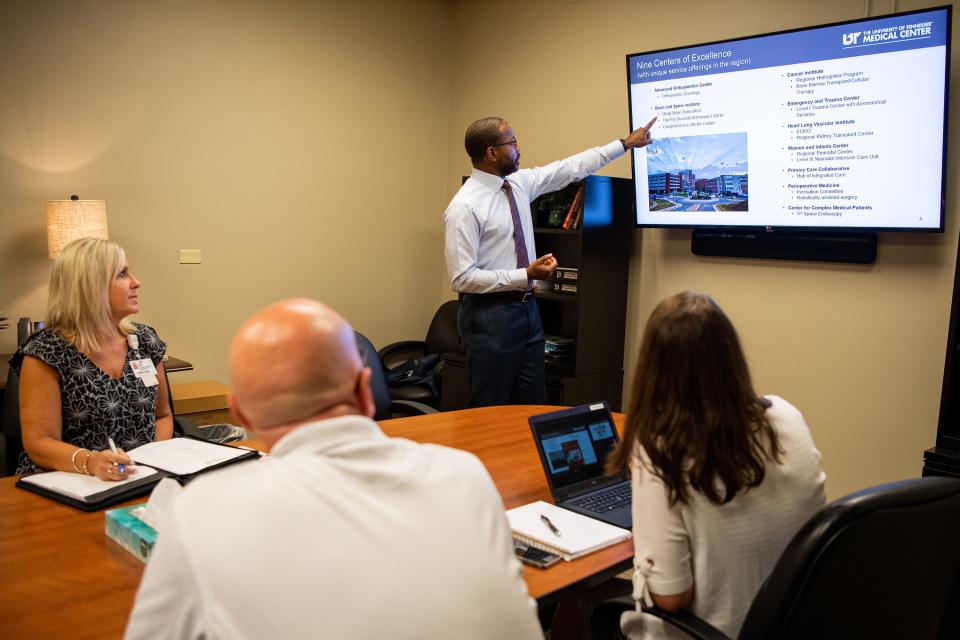How Dr. Keith Gray plans to build patient trust as UT Medical Center's next leader
Dr. Keith Gray wants to help people in Knoxville and East Tennessee get healthier by meeting them where they are, exploring telehealth options and identifying what patients need at the University of Tennessee Medical Center's main campus.
He'll do all that and more as the next leader of UT Medical Center.
He's been on a quick trajectory with a vision for UT's services. After graduating and completing his residencies, Gray joined UT Medical Center as a surgical oncologist. Sixteen years later, he's its president and soon-to-be CEO. He became known to the wider community as a key leader as the world battled COVID-19, partnering with faith leaders to share health updates and vaccine information.
As his career took different forms, his passion remains the same: identifying the needs of patients and serving them in whatever form they need.
Gray will succeed Joseph Landsman Jr., who will retire as CEO on April 1. Dr. James Shamiyeh will become Gray's right hand as executive vice president and COO.
Knox News sat down with Gray to discuss how he will lead UT Medical Center and its 8,000 employees, plus his future plans for health services in East Tennessee.
This interview has been lightly edited for length and clarity.
What will your day-to-day operation look like when you take over your new roles?

From a leadership standpoint, I believe that a leader is responsible for not necessarily doing or knowing everything, but really empowering the people that he or she leads to be able to do their best job. So really helping the folks that I'm overseeing that report to me to be more effective in their position.
For example, I don't have a background as an accountant or as a CFO, but my job is to help the current CFO with the resources that he or she needs to be the best steward of our hospital's funds. From a philanthropy and health equity standpoint, health equity has always been a passion of mine. It's really to help set the vision for health equity in this community, which is ensuring that every member of the 21-county area and beyond has an opportunity to achieve their best health, and really working with (senior vice president and chief philanthropy and equity officer) Kathy Boyd … to understand what that vision looks like.
What does it mean to you now to be stepping into the CEO role?
First of all, I want to acknowledge that the current president/CEO role has been split into a president role, which I now occupy, and then the CEO is still here, Mr. Landsman. I just want to acknowledge what he has accomplished during his tenure in that role. Our hospital has grown significantly from every standard of measurement, which has allowed us to take care of many more people in our community and expand our impact area.
One of my goals is to continue to build on the foundation that he's already established. On this main campus, we have nine Centers of Excellence. We will continue to serve patients with that Center of Excellence approach, which is a multidisciplinary approach and a disease-specific approach.
From a community footprint standpoint, Mr. Landsman has been very strategic and intentional about expanding our geographic footprint, realizing that not every person can or should come here, but that they can access high-end services right where they live. We've got an expansive primary care footprint. Our community has access to specialty services through our Regional Health Centers.
We also are concerned about rural health, and a prime example of that is our freestanding emergency department, which we opened two weeks ago. So to continue to expand on that strategy, and then understand what services we need that we don't currently have, be strategic about developing those services and then just really listening to our team members in our community to understand other needs that may arise.
What do you hope to accomplish now and when you assume the CEO role next year?
We just finished our latest strategic plan, and our vision is to transform the health of individuals in our community as a top tier academic medical center.
There are three parts to that.
One is transformation, and really understanding what transformation of health in this community looks like. We have some health outcomes and health care challenges in Tennessee. When you look at health outcomes, we're always in the bottom 10 states. I want that to be different at the end of my career. I want us to have measurable impact on the health of this community.
And then every individual. That speaks to our health equity vision. It's not just, "Hey, we have services and they are here for you if you choose to take advantage of them." We want to understand that every individual in our community has a different situation, and I want them to be able to access high-end services, whether that's primary care or specialty services, regardless of where they live in those 21 counties.
The last piece of that is that top-tier academic medical center. We are the region's only academic medical center, and that goes back to our mission. We serve through healing, which is clinical care. We serve through education training the next generation of provider, not just physician but all types of health care providers. And then we want to do research that's meaningful to impact the health of this community as we move forward.
What will those changes to clinical services, educational programs and research look like moving forward?
The changes will respond to the needs of the community. It's hard to look five or 10 years out and tell you exactly what those will be.
Let's go back to the start of the COVID-19 pandemic in 2020. During that three-year period, we were able to launch three new services that did not exist in our region: bone marrow transplant, ECMO (extracorporeal membrane oxygenation) and deep brain stimulation for patients with movement disorders.
We will continue to assess the needs of our community and bring new programs like that in the future. For example, telehealth. As our population ages and grows, not everyone can or should come here. We want to learn how to better serve them, and telehealth and Hospital to Home are ways in which we can do that.
As far as education, we realize that one of the issues we have is access to specialty care, and we can't attract enough physicians to fill the need in this community especially as it relates to gastrointestinal, neurology, behavioral health and rheumatology. Part of our strategy is to develop a pipeline where we train and grow our own in order to meet the future needs of the community.
From a research standpoint, we can do research for research's sake. But what are the issues that plague our community? One of those is is health disparities. We have significant disparities in our community, urban and rural. We have the unique opportunity to be leaders in disparities research, especially Appalachian disparities research.
Are there any plans to expand the University of Tennessee Medical Center's main campus?
We're always looking for ways to better accommodate our patients and create better access. That is local and regional access. We're looking for ways now to decompress our campus so that only the patients that need to be here for acute care services are here. Otherwise, if you can access those services near your home, we want you to be able to do that.
So yes, we will continue to expand and modify this campus to meet the community need. If that's more inpatient beds, we'll look to that and we'll do that. If it's a better and more efficient emergency room, we'll do that. But it will only be to meet the needs of the patients that really need to be on this Alcoa campus.
Can the medical center expand to other locations?
I think our regional health center strategy is that. We currently have four (located in Hamblin, Sevier, Knox and Loudon counties).
Again, understanding where the need is and where the population growth is, and then creating access there that not only gives them access to primary care services but also to diagnostics, to lab services, to infusion services and to specialty care. That's our way of expanding and creating almost mini hospitals in the communities where the patients can more easily access them.
Does the patient experience need to change in order to accommodate for the center's growth?

I think the entire health care experience, not just the patient but the team member experience, needs to evolve.
I think there's a lot that we can learn from other industries related to experience and customer service. We've been working a lot on understanding when the patient experience starts and when it ends, and really trying to put things in place to influence that experience all along the way.
For example, when you need access to health care services, we want the region's academic medical center to be top of mind for you. We know that we've got to do our due diligence as it relates to how attractive our facility is, how robust our marketing programs are. And then once they arrive on this campus or any of our regional health centers or satellite locations, we want for it to be easily accessible and for them to have a great first impression of our campus and other people that they meet.
We want to quickly establish the trust of that patient. We want that patient to feel like they've been listened to, and that we understand and care about what's going on with them. That in turns builds the trust of the patient between the provider and the patient and that starts to build that continuous relationship where we can continue to meet their needs no matter what they are.
But an important part of that experience as well is our team members' experience. Because we realized that if our team members understand our vision, and they wake up knowing what their part to play in achieving that vision is, then they're excited about coming to work. And if they're excited about coming to work, you're going to get good care.
What else would you like to say about this next phase of UT Medical Center?
Moving forward, UT Medical Center as the region's academic medical center is here to meet the comprehensive health care needs of this community. But we realize that health care delivery is only a small fraction of overall health care outcomes. So from a health care equity standpoint, we're going to develop strategic partnerships within the community (in industries like housing, parks and recreation, nutrition and education) to really improve the overall wellness and well being of our community.
Keenan Thomas is a higher education reporter. Email keenan.thomas@knoxnews.com. Twitter @specialk2real.
Support strong local journalism by subscribing to knoxnews.com/subscribe.
This article originally appeared on Knoxville News Sentinel: University of Tennessee Medical Center president Keith Gray shares goals

